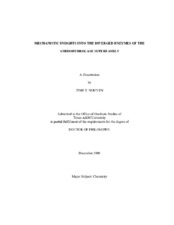| dc.description.abstract | The amidohydrolase superfamily is a functionally diverse set of enzymes that
catalyzes predominantly hydrolysis reactions involving sugars, nucleic acids, amino
acids, and organophosphate esters. A more divergent member of this superfamily, URI
(uronate isomerase) from Escherichia coli, catalyzes the isomerization of D-glucuronate
to D-fructuronate and D-galacturonate to D-tagaturonate. In Bacillus halodurans, two
distinct operons were identified for the metabolism of D-glucuronate and D-galacturonate
based on kinetics and genomic context. The canonical uronate isomerase is encoded by
the gene Bh0705. A second URI in this organism, Bh0493, is the outlier of the group in
terms of sequence similarity. Kinetic evidences indicate that Bh0705 is relatively
specific for the isomerization of D-glucuronate, while Bh0493 is specific for the Dgalacturonate
pathway.
Bell-shaped pH-rate profiles were observed for the wild type URI from
Escherichia coli. Primary isotope effects with [2-2H]-D-glucuronate and solvent
viscosity studies are consistent with product release as the rate limiting step. X-ray
structure of Bh0493 was determined in the presence of D-glucuronate. A chemical mechanism is proposed that utilizes a proton transfer from C-2 of D-glucuronate to C-1
that is initiated by the combined actions of Asp-355 and the C-5 hydroxyl of the
substrate that is bound to the metal ion. The formation of the cis-enediol intermediate is
further facilitated by the shuttling of the proton between the C-2 and C-1 oxygens by the
conserved Tyr-50 and/or Arg-357.
Another divergent member of the AHS is the enzyme renal dipeptidase.
Structural studies of the enzyme from Streptomyces coelicolor (Sco3058) demonstrate
that the active site consists of a binuclear metal center. Bell-shaped pH-rate profiles are
observed for both Zn2+ and Cd2+ enzymes. A chemical mechanism for renal dipeptidase
is proposed based on structural analysis of the enzyme-inhibitor complex. The reaction
is initiated by the polarization of the amide bond by the B-metal. Asp-320 activates the
bridging hydroxide for nucleophilic attack at the peptide carbon center, forming a
tetrahedral intermediate that is stabilized by the metal center and His-150. The
protonated Asp-320 donates the proton to the a-amino group of the leaving group,
causing the collapse of the tetrahedral intermediate and cleavage of the carbon-nitrogen
bond. | en |


